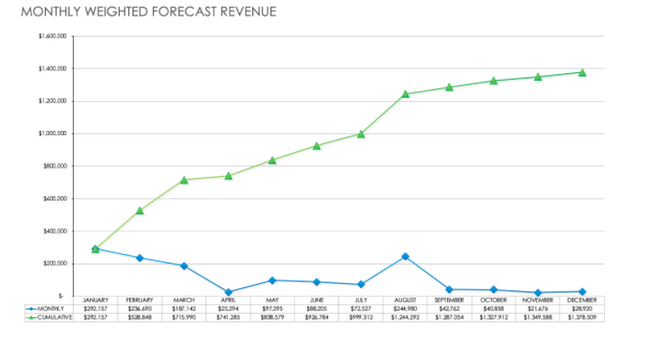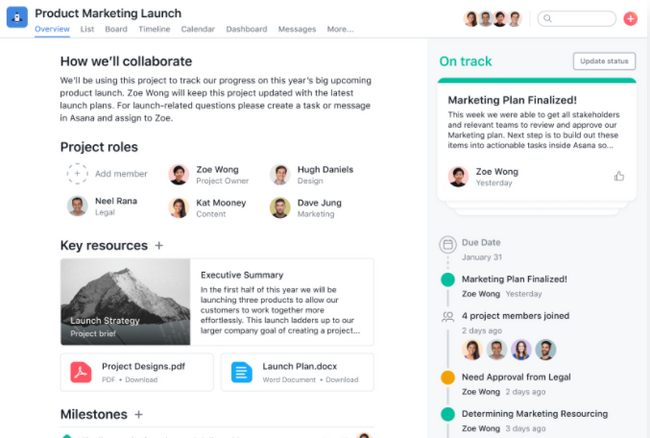
In an ideal world, sales teams and business leaders would have crystal balls to help them predict accurate sales forecasts.
With these predictions, it would be easier to create budgets, set goals, know when you’ll need to hire more people, and so much more.
Unfortunately, crystal balls belong in the movies, and predicting anything in business, especially revenue, can be challenging.
Then what’s the best way to go about creating sales forecasts for your business?
Firstly, you need to understand what forecasting is.
In a nutshell, a sales forecast is your predictions of what you will sell weekly, monthly, quarterly, or annually.
An important element for forecasting is to be more realistic than hopeful. Too often, sales teams will be overly optimistic when setting goals.
This, unfortunately, leads to disappointment when you’re halfway through the year and your team starts realizing that you’re still far from reaching your goals.
I want better for you. I want you to set goals that you can reach. Goals that will help keep you and your team motivated.
Here’s my detailed breakdown of how to predict your business’s future revenue.
Pros and Cons of Doing Your Own Sales Forecasting to Predict Revenue
Some business leaders and sales teams decide to create their own forecasts. Is this a good idea?
Well, let’s have a look at some of the advantages and disadvantages of this.
Pro 1: You’ll Gain Valuable Insight
Since forecasting involves looking into historical and real-time data, you are forced to gain insight into your business’s health and overall growth. This information can help you set better future goals for your business.
Pro 2: You Can Decrease Costs
If you have a small business or startup, you’re likely trying to cut costs any way you can. Doing some essential tasks on your own, like revenue predictions, will help you save costs that you can channel into other areas of your business.
Pro 3: You’ll Know What to Focus On
There are many moving parts to a growing business. Understanding each component helps you achieve your overall business goals.
When you do your own sales forecasts, you’ll know what you need to focus more on to help your business continue growing.
For instance, if you predict that your sales will increase by 5 percent in the next three months, you can then allocate the necessary resources to help your sales team achieve this goal.
Con 1: Sales Forecasting Takes Time
As highlighted above, you’ll need to create revenue predictions that may be weekly, monthly, quarterly, or annually.
To create these forecasts and make an informed decision, you’ll have to look into historical data. This can be time-consuming to do on your own.
Con 2: Lack of Input From Outside the Company
Sometimes, it’s challenging to see the whole picture when you’re in the frame. Employing a team of planners from outside the organization can help you get someone else’s informed decision on your company. This can give you valuable insight into the health of your company.
If you’re the business owner, it’s challenging to be subjective and remove all emotions when creating forecasts. Your business means a lot to you.
You’re working hard to ensure that it’s a success. If you’re not careful, your projections have the potential of being more optimistic than realistic. An outsider will be more objective and base each decision on real data.
If you’ve weighed up your pros and cons and feel that you would like to create your own forecasts, it’s now time to understand how these can benefit you.
Why Use Sales Forecasts?
Before we get to how we first need to understand why we need sales forecasts in the first place. What value do they add to your business?
When you build a solid sales forecast, you can foresee potential issues and work on fixing them.
For instance, if you’re halfway through the year and see that your sales are trending 20 percent below quota, you can quickly assess the situation to figure out what is preventing you from achieving your goals.
Figuring out potential problems right away, instead of waiting until the end of the year or the quarter, can make a huge difference in any business.
Having you and your sales team be aware of the sales forecast can work as a great motivation tool. You can have weekly or monthly sales updates to let the team know how far you are from reaching your goals.
An important thing to remember when building sales forecasts is that they won’t be perfect. By the end of the quarter or financial year, you might be below your goals, or you might have surpassed them.
Whatever the case may be, creating forecasts is still a necessary part of your business plan as they help you and your team stay on the same page and work toward common goals.
Instructions for Creating a Sales Forecast to Predict Revenue
Now that you understand the value of building a solid sales forecast, let’s get into how to get it done.
1. Pick or Create a Sales Forecast Template
What specific information do you want to get out of your sales forecast? This is an important question as the answer will help you decide on the template that makes the most sense for you and your business.
You may want to look at information like:
- How much revenue you currently earn in a quarter, and how much you predict to make in the next quarter.
- Are you introducing a new product? How much revenue should you expect to generate from the product, considering past and current market trends?
You may be able to find a template for what you’re looking for, or you can create a unique template that includes all the metrics you’re interested in tracking and makes the most sense for your business.
2. Select the Products Included in Your Sales Forecast
The products you include in your sales forecast will depend on what you’re specifically forecasting. For instance, if you decide to create a quarterly sales forecast, you may include all your sales for that period.
On the other hand, if you want to forecast sales for specific verticals or products, you’ll probably only have those products.
It’s essential to be as specific as possible and also be clear on how you would like to incorporate the products you’ve selected for consideration in your forecast.
For instance, if you’ll be forecasting sales across a quarter, you need to decide how to set your actual forecast.
You can include a line prediction for each product you sell, and you can include another line item for how much you expect to sell in your different product lines or categories.
If you would like to create a medium- to long-term forecast (e.g., over a 12-month period), you can develop monthly forecasts leading up to that period.
These forecasts can include the price per unit and units sold for each product.

3. Calculate Predicted Revenue
Now’s the fun part: calculating your predicted revenue. There are multiple ways you can predict future revenue.
You Can Use Historical Data
If you’ve been selling your products or services for a while, looking into your historical data to give you an idea of a realistic revenue you can expect to achieve is essential.
While considering historical data can help, it’s not always an accurate predictor of future sales. For instance, you might have been a newcomer in the past, but now you may be well-established in your industry.
The sales you received in your first year won’t match the sales you’ll receive in this coming year.
While this is true, it’s always important to consider historical data as this is your foundation. You can use this information as a baseline for your sales goals.
You Can Consider the Season
Some products are seasonal, while others sell at a consistent rate all year long. There are also certain times of the year (e.g., Black Friday, Cyber Monday, and Christmas season) where consumers generally spend a lot of money. These factors will affect your revenue during these periods.
You Can Consider the Market
No matter how amazing your product or service is, sometimes there’s a ceiling regarding how much you can realistically sell at certain times. For instance, if you sell gadgets, what used to be “cool” five years ago may not be today.
The tech space is constantly evolving, and if your products or services don’t get updated to meet consumer demands, your revenue might tend toward a downward trend.
After considering all these factors, you can look at the best-case scenario and then predict sales based on that number.
Again, it’s essential to be realistic here. If you own a pizza place and your only competitor from across the street sells an average of 50 pizzas per day, predicting to sell 1,000 pizzas per day is more hopeful than realistic.
Many professionals use scenario analysis to help them understand what the best- and worst-case scenarios may be for their predicted revenue.
4. Create a Tracking System
Creating a tracking system is one of the most crucial elements to successfully forecasting.
If, for instance, you find that you’ve made predictions that are way off when you’re in the middle of the sales cycle, referring to your tracking system will help you immediately see this. You can then quickly update or adjust your sales forecast.
The tracking system you use doesn’t need to be complicated. For example, you can create an Excel spreadsheet and even create graphs, like this one from SmartSheet, to help you see whether your sales are reaching, below, or surpassing your predicted revenue.

5. Ensure Your Team Is Aligned
The value of having a team that’s working toward the same goals can’t be overstated. That’s why it’s essential to ensure that every team member is aware of the sales forecasts and, more importantly, that they agree with them.
Why?
While you may be the leader, you can’t achieve your predicted sales on your own. You need everyone to work toward reaching those goals and also believe in them.
Sharing with your team can also help you get their valuable opinions on the predictions you made.
Maybe you missed an important factor that might affect sales for that period. Or maybe there’s a new trend in the market that your sales team recently discovered. Their input is essential before the stakeholders sign off on the sales forecasts.
6. Use Tools to Make Your Sales Forecast Process Easier
We’re well into the digital age, and there are various tools that can help make your life a little easier.
For instance, you can use Google Sheets to create your forecasts in a neat spreadsheet. Furthermore, you will be able to access them from any device with internet access.
To keep in touch with your team and share regular updates on forecasts, you can use online collaboration tools, such as Asana, Trello, or Slack.

All these tools allow you to share links and documents with your team members so that they can access valuable information at any time.
When choosing tools, look for options that are easy for you and your team to use and integrate. It’s also important to pay close attention to the privacy policies of the organizations. In addition, consider tools with multiple features to make organization a little easier.
Conclusion
Sales forecasting is an essential part of your business, but sometimes generic templates aren’t relevant. Use the above tips to create an informed sales forecast that will work for your needs.
Have you created a sales forecast model before? What interesting tips can you share?
The post How to Build a Sales Forecast Model appeared first on Neil Patel.
from Blog – Neil Patel https://ift.tt/3koyDyB

No comments:
Post a Comment